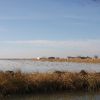Coalition on Agricultural Greenhouse Gases

Demonstrating GHG Emission Reductions in California and MidSouth Rice Production
Project Timeline: August 2011 - July 2014The project’s goal is to create incentives for US rice producers to reduce their GHG emissions by participating in voluntary and compliance carbon offset markets. The project is field-testing a subset of GHG-reducing practices and is developing user-friendly technology that combines performance- and practice-based approaches to help producers access carbon markets. These practices and the quantification of their reduction potential rely on the DNDC model (DeNitrification DeComposition). These pilots, along with assessments of economic and environmental impacts, will provide a more cohesive understanding of replication potential across the nation's rice-producing regions. Lessons learned with rice producers and the creation of a methodology will support the eventual transfer of conservation technologies and innovative market-based approaches into NRCS policy and programs.
This initiative builds on recent work by Environmental Defense Fund (EDF) in California and Winrock International (Winrock) in Arkansas, carried out in collaboration with the leading rice industry associations and rice producers in each region. The project has funded the development of a methodology awaiting approval by American Carbon Registry in late 2012. Separately, Climate Action Reserve has also approved a rice protocol and California’s Air Resource Board will be developing its own rice protocol by the end of 2013. Each of these will be developed or revised to include appropriate practices in both California and the Midsouth region.
After the first year of the grant, we have established two pilot projects, one each in California and the Midsouth (Arkansas and Mississippi), with EQIP-eligible producers.
California: There are eight producers (roughly 9,000 acres) involved in our California demonstration project. Practices include dry seeding, baling, reduced winter flooding, and early drainage. Our project partner PRBO Conservation Science is assessing environmental impacts of the chosen GHG mitigating practices in California.
Midsouth: Because the DNDC model was validated for California in a previous CIG project, the previous year’s efforts in the Midsouth have been focused on collecting data and identifying practices with economic benefits to producers in addition to GHG mitigation (may differ from practices in CA).
The CIG funding will help with monitoring, verification and registration of the resulting GHG emission reductions on a carbon registry for both pilot projects. A new user interface web tool will allow farmers, project developers, and verifiers to efficiently access this offset credit information, including economic modeling of the projects that will help predict estimated returns to producers.
Credits will be verified and sold in 2014 (up to two years’ worth for each site).
Project Summary
The purpose of this GHG CIG project is to 1) implement a first-of-its-kind greenhouse gas (GHG) emission reduction demonstration initiative with rice producers in California and Arkansas, two of the country’s leading rice-producing states and 2) analyze the demonstration's replication potential in other rice producing states including Louisiana, Mississippi, Missouri, and Texas.
Successes & Challenges
Successes:
- Involvement of producers who are willing to test new practices in the pilot project, as a result of the California Rice Commission in CA and the White River Irrigation District in Arkansas.
- The level of progress with the rice project that has encouraged ARB to consider a rice protocol as the first agricultural compliance protocol.
- Innovative technology (i.e. remote sensing) to provide easier and less expensive means of verification
Challenges:
-
Project feasibility:
- Dealing with small emission reductions on individual fields across landscapes and how to aggregate these projects
- Transaction costs including verification
- Methods of verifying land-based, aggregated projects
- Cumulatively, understanding the time and costs to farmers to implement a project and how this will affect the adoption of practices - Getting sufficient measurement data needed to validate DNDC (mostly availability of data)
- Operating with uncertainties due to the addition of more data sets and potential changes in modeling and emissions reductions estimates
- Balancing resource concerns (ex. GHGs, wildlife habitat)
- Overcoming growers' perception of agronomic risk associated with certain practices
Project Partners
- Candice Chow-Gamboa
Environmental Defense Fund [email protected] - Paul Buttner
California Rice Commission [email protected] - Belinda Morris
American Carbon Registry, an enterprise of Winrock International [email protected] - Steven De Gryze
TerraGlobal Capital [email protected] - Bill Salas
DNDC-Applications, Research, and Training [email protected]
Project photos
Contact
- Candice Chow-Gamboa (EDF)
916-492-7172
[email protected] - Paul Buttner (California Rice Commission)
916-387-2264
[email protected] - Belinda Morris (American Carbon Registry)
916-520-8628
[email protected]
©2015 Coalition on Agricultural Greenhouse Gases (C-AGG). All rights reserved.


Post a comment